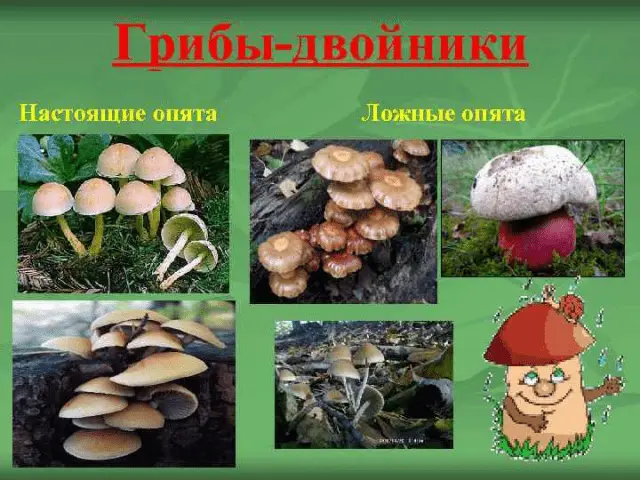Contents
Going to the forest, the mushroom picker should stock up not only with a knife and a basket, but also with knowledge of the characteristic features by which false mushrooms differ from real ones. If the latter, correctly collected and cooked, are edible and tasty, then eating some varieties of their “twins” can cause severe poisoning. The ability to distinguish forest mushrooms from false ones can save the lover of “mushroom hunting” and his loved ones health, and sometimes life.
General description of false mushrooms
The first thing that will help you figure out how to distinguish false mushrooms is a photo and a description of their various types.

It is difficult to classify these mushrooms. Their species diversity is widely represented within the framework of several families at once (strophariaceae, dung beetles, according to another taxonomy – psatirellaceae).
With edible “brothers” they are united by the season in which they grow and the habitat – hemp, fallen trees, deadwood, tree roots and trunks.
Due to the similarity of external signs – growth in large groups, convex lamellar caps, thin and long legs, hollow inside – it is difficult for a non-specialist at first glance to determine which mushrooms are in front of him. Mushrooms are false and “normal”, it happens that they even grow next door on the same stump.
If there is even the slightest doubt whether it was possible to correctly recognize: mushrooms are false or not, it is not worth taking risks by cutting these mushrooms into your basket. You should not take everything in a row to figure it out at home or ask specialists. If at least one poisonous mushroom got into the basket, the rest will have to be thrown in – they can no longer be eaten.
Are false mushrooms dangerous
Many varieties of these mushrooms are considered inedible and poisonous – they should not be eaten under any circumstances.
Some species are conditionally edible. After proper processing (soaking, boiling), it is allowed to cook dishes from them.
What honey mushrooms look like edible and false (photo)
Edible and false mushrooms look almost the same.
However, there are a number of differences that make it possible to separate one from the other. Pay attention to the following:
- hat color and shape
- the color of the plates on its inside;
- the presence of scales on the surface;
- the presence of an annular growth (“skirt”) around the stem of the fungus;
- smell.
The photo will help to imagine how to distinguish between false and edible mushrooms:
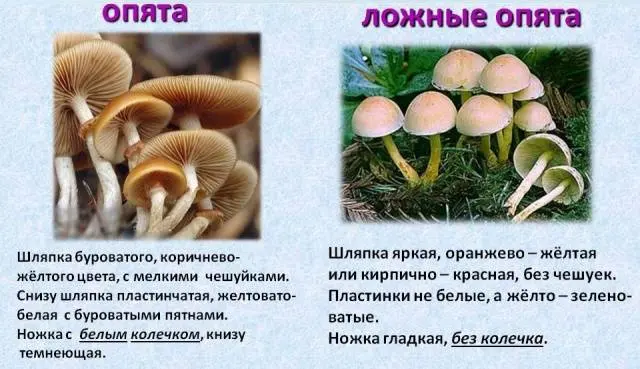
False honey mushrooms, similar to edible
It is necessary to dwell in more detail on the characteristics of the most common types of mushrooms, known as false mushrooms, give their photos and descriptions.
How to distinguish a bordered galerina from mushrooms
One of the most dangerous types of false mushrooms is bordered galerina.

Characteristic signs of bordered galerina:
Edible or not | Poisonous |
head | Small (1-4 cm), bell-shaped, later becomes flat. Color ocher, brown |
Records | Medium, yellowish (turn brown with age) |
Pulp | Thin, dirty-yellow, with a slight smell and floury taste |
Leg | 2–5 cm, fibrous, hollow, slightly thickened below. There is a yellow ring |
Season | June – October |
Habitat | Decayed pine and spruce wood |
How it grows | Groups of 2-3 pcs. |
The difference between this type of false mushrooms and real mushrooms will help to present a photo:

Summer honey agaric:
- larger (hat – up to 6 cm in diameter);
- grows in large “families”;
- the pulp has a pleasant smell and taste;
- the lower leg is covered with scales.
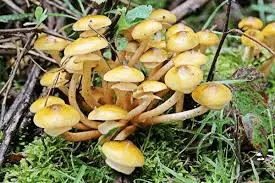
Autumn honey agaric:
- grows in large bunches;
- the pulp is thicker;
- the surface of the stem and cap is covered with scales.
Upenok Kandollya
The photo below shows what Kandoll’s false mushrooms look like:
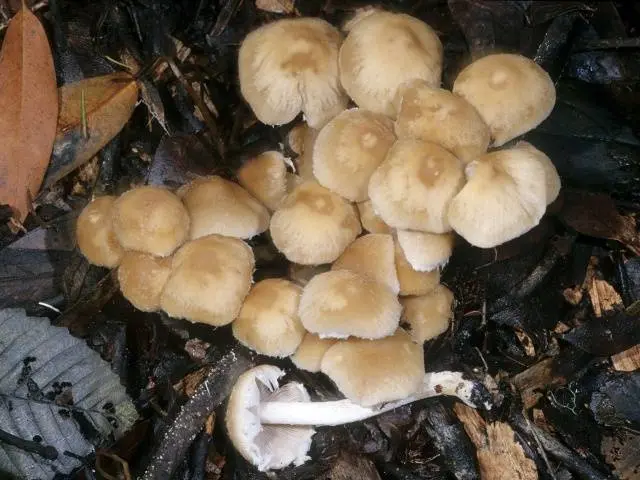
Edible or not | Conditionally edible |
head | Small (3–7 cm), resembles a bell, in a mature one it is umbrella-shaped with a ledge in the center. The color varies (from white to yellowish brown). White “fringe” along the edge |
Records | Grey, turning brown over time |
Pulp | Milky brown, with a pleasant mushroom smell |
Leg | About 10 cm. Hollow, white, slightly pubescent below |
Season | May – September |
Habitat | Deciduous tree roots, stumps |
How it grows | large groups |
Psatirella hygrophilous
In this photo of false mushrooms – psatirella, or moisture-loving chrysanthemum (hydrophilic, spherical), otherwise known as watery false honeycomb. On the territory of Our Country, this species is very common.
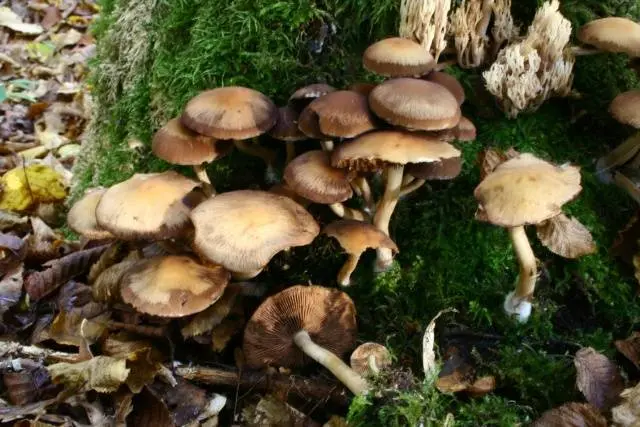
Edible or not | Conditionally edible (according to other sources – inedible) |
head | Convex, 2–6 cm in diameter. Later it becomes flat. Color – from cream to chocolate |
Records | Light (darken with age), frequent |
Pulp | White-cream in color, relatively dense, has no pronounced smell and taste |
Leg | Hollow, but dense, smooth, 3–8 cm. Light, covered with powdery coating. There is a false ring |
Season | June – October |
Habitat | On woody remains and stumps |
How it grows | Large groups, uniting in bunches |
Poppy honey agaric
An idea of how false mushrooms look like can also be obtained using the example of poppy, or serolamella.
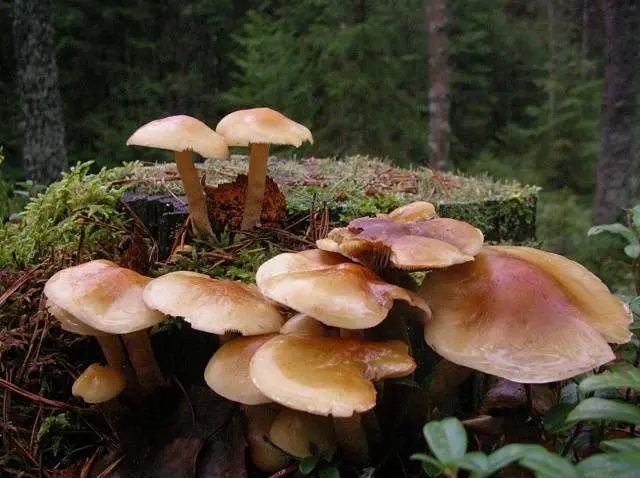
Edible or not | edible |
head | Medium (3-7 cm), it can be both in the form of a hemisphere, and prostrate, with a bulge. Colour: Dull yellow to brown |
Records | Adherent, light yellow, often arranged |
Pulp | Pale, thin, faint smell of dampness |
Leg | 5–10 cm, sometimes curved, yellow above, reddish brown below |
Season | Spring – autumn (sometimes even mild winter) |
Habitat | Coniferous forests, stumps and roots covered with earth |
How it grows | In bundles |
Sulfur yellow honey agaric
It is very important for the mushroom picker to keep in mind the description and differences of the false sulfur yellow mushroom, since this species is not just inedible, but poisonous.
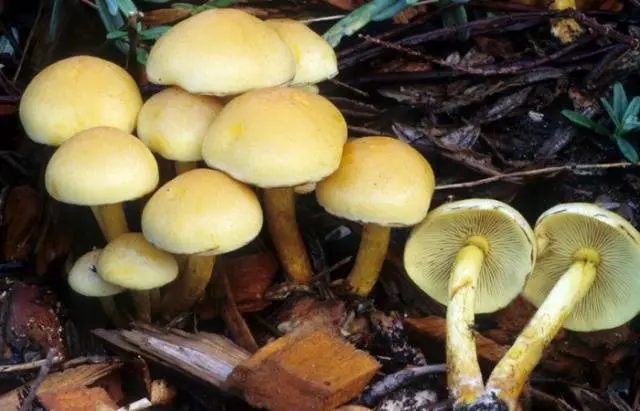
Edible or not | Poisonous |
head | Small (2–7 cm), bell-shaped, then becomes similar to an umbrella. Color – yellowish with a dirty brown or gray tint, the center is darkened |
Records | Grown. In young mushrooms – sulfur-yellow, then change color to olive or greenish |
Pulp | White or yellow-white. Bitter in taste, with an unpleasant odor |
Leg | Approximately 10 cm, light yellow, fibrous, straight |
Season | June – October |
Habitat | Decayed branches and trunks, the surface of stumps and the area around them |
How it grows | Big “families” |
Brick red honey agaric
The photo below of hemp false mushrooms shows the species known as brick red.
In Europe, this mushroom is not considered edible, but dishes from it are quite popular in Japan and the United States.
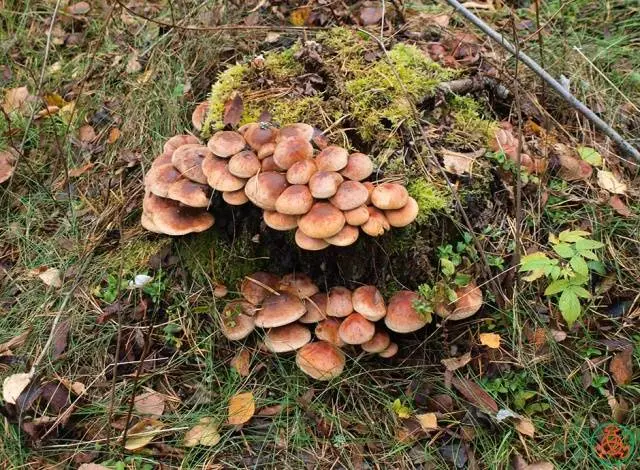
Edible or not | Conditionally edible (but requires a long boil) |
head | Large (from 4 to 12 cm), convex, but becomes flatter with age. Red-brown color (darker in the center) |
Records | Yellow, over time – brown, adherent to the leg |
Pulp | Pale yellow, bitter taste |
Leg | Pale yellow above, brown below |
Season | August – October |
Habitat | dead wood |
How it grows | In groups |
How to distinguish false mushrooms from real ones
A photo and analysis of a certain set of signs will help you learn to distinguish false mushrooms from real ones:
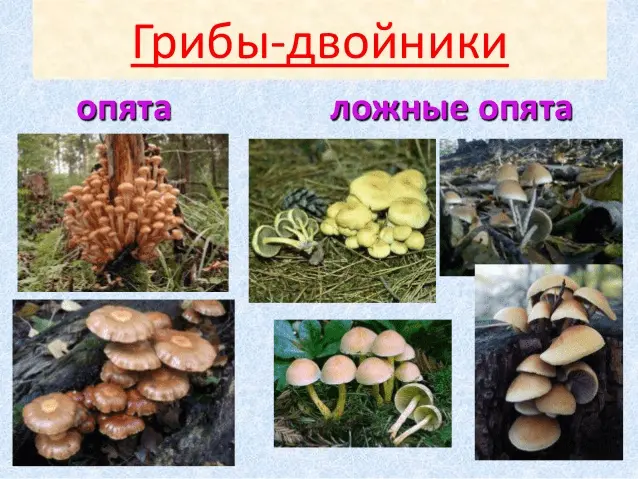
Video will help you learn how to distinguish false mushrooms from real ones
Appearance of mushrooms
The false and edible mushrooms shown in the photo can be identified correctly if you look closely:
- hats of false species are more brightly colored (bright yellow, terracotta red), while those of edible species are relatively modest, mostly pale brown;
- young edible specimens often have scales on the surface of the cap and stem, while scaly false mushrooms are not found;
- plates on the back of the cap in edible species are usually white-yellow or creamy, in false varieties their color is greenish or olive-black;
- edible mushrooms are characterized by a noticeable leathery ring (“skirt”) around the stem, in false ones it is hardly noticeable, if not completely absent.
Here is another photo showing the differences between false and real mushrooms:
How do false mushrooms differ from edible ones by smell
Their smell will help to distinguish true mushrooms from false ones:
- thanks to the essential oils in the composition of edible specimens, they smell pleasantly of mushrooms (and the aroma intensifies during the cooking process);
- the smell of false varieties is unpleasant – they smell like mold, damp earth or rotten grass.
Taste
The taste of false mushrooms is unpleasant, bitter – however, it is quite natural that they are tried not raw, but already cooked.
Signs of poisoning with false mushrooms
Knowing the signs of poisoning with false mushrooms will help to quickly and competently provide first aid to the victim. Then you should, without wasting time, consult a doctor.
Symptoms of poisoning with false mushrooms
Typical symptoms of poisoning with false mushrooms:
- the occurrence of heartburn, nausea, discomfort in the stomach;
- the appearance of dizziness;
- after a few hours, lethargy, apathy occurs, weakness increases, the limbs begin to tremble;
- nausea intensifies, vomiting and diarrhea occur, accompanied by cramps, sharp pains in the abdomen;
- cold sweat appears, including on the palms and feet;
- possible loss of consciousness.
First aid for poisoning with false mushrooms
Symptoms of poisoning with false mushrooms appear after a short period of time (according to various sources, from 1 to 6 hours) after eating mushrooms. During this period, it is important to take emergency measures as soon as possible:
- rinse the stomach (induce vomiting after drinking a large amount of clean cold water);
- ensure the intake of enterosorbents (activated carbon, polysorb, atoxyl);
- organize a plentiful drink;
- seek qualified medical attention.
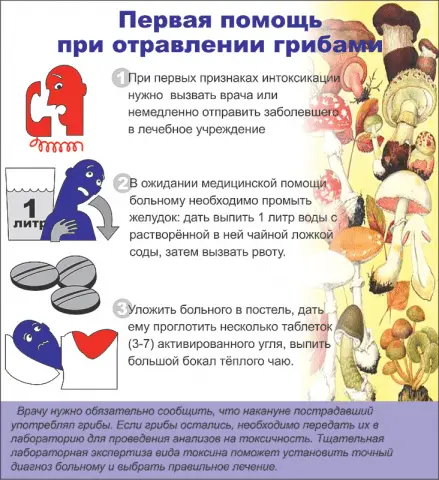
The consequences of poisoning with false mushrooms
The toxins contained in the juice of these mushrooms enter the blood through the gastrointestinal tract, and with its current they are carried throughout the body.
If the patient does not receive help, this may manifest:
- severe headache and dizziness;
- slowing of the pulse and a drop in blood pressure (sometimes even to critically low values);
- blueness of the skin;
- hallucinations, delusions (as a result of prolonged dehydration);
- alternating periods of inhibition and excitation.
With proper treatment provided on time, the victim, as a rule, recovers in a few days. The risk of death is small, but it exists – first of all, for a child or a weakened organism.
Is it possible to eat false mushrooms
It is possible to eat only those species that are conditionally edible. This is considered undesirable, but acceptable subject to all the subtleties of culinary processing. First, they are soaked in water for a long time, then boiled thoroughly.
These mushrooms should not be eaten raw. Moreover, if you eat false mushrooms, which are considered conditionally edible, but cooked incorrectly, it will be dangerous for health.
How to check false mushrooms when cooking
There is an opinion among mushroom pickers that it is possible to distinguish mushrooms from false ones when cooking. To do this, it is advised to lower the peeled cut onion or cloves of garlic into the pan where the mushrooms are boiled. If the roots turn blue or brown, it means that there are poisonous specimens there.
How else can you check if mushrooms are poisonous or not
In addition to the “folk” method above, there are some more common tips on how to determine whether a false honey agaric is poisonous or not. You can often hear suggestions:
- cut a raw mushroom and rub it against a silver cutlery, if it darkens, toxic substances are present in the product;
- dip a dubious honey agaric into raw cow’s milk – the poison will help it quickly turn sour.
There are even more “curious” ideas, which in fact are dangerous delusions:
- “If the mushroom is eaten by insect larvae, this speaks in favor of the fact that it is not poisonous” – not true. What is not a poison for insects may well be a danger to humans.
- “If you boil mushrooms for a long time with the addition of vinegar and salt, you can “boil” poison out of them” – not true. This method is conditionally suitable only for some species, in the fruiting bodies of which there are few toxins, in the vast majority of cases it will not work.
- “Alcohol can help neutralize mushroom poison” is not true. On the contrary, drinking alcohol will help the toxins spread much faster!
Conclusion
False mushrooms are mostly inedible, and even poisonous “twins” of ordinary species, found in abundance during the mushroom season. Mushrooms false and “normal”, upon closer examination, have a number of differences in color and structure of the surface of the cap, legs, the presence or absence of a “skirt”, the color of the plates and smell. The mushroom picker should study these features well and be guided by them, and not by dubious tips heard “among the people”. Just in case, you need to remember how to recognize mushroom poisoning, and be able to provide first aid.










